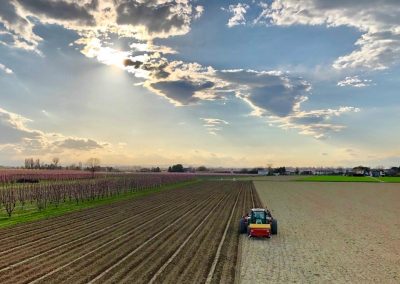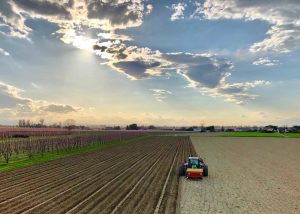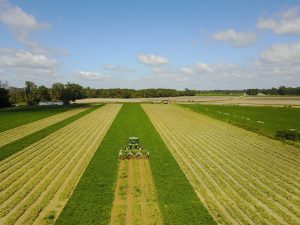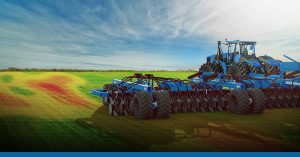State of the Industry: Adoption of Precision Ag Grows as Farm Sizes Grow
March 14, 2019


Since the first auto-steer tractor was introduced in the 1990s, precision agriculture has only gained traction amongst farmers for its cost and time savings benefits—and it’s a trend that’s not likely to slow down anytime soon.
Farms are growing in size, according to a 2018 USDA Economic Research Service (ERS) report, which found that in 2012, the percent of cropland on farms with at least 2,000 acres was more than double the percent in 1987, from 15% to 36%.
The trend for larger farms is thanks in part to precision technology. The ERS report says that technologies like GPS guidance systems, yield and soil mapping, and variable-rate technology (VRT) “appear to have spurred further increases in farm size,” as they allow farmers to manage more land.
And as farms continue to grow, so will their use of precision ag. A 2016 ERS report found that larger farms are more likely to adopt these technologies, with some of the highest adoption rates being on farms with more than 3,800 acres.
This growth in both farm size and use of technology will require farms to be more connected and integrated than ever before. Both people and machines will need to be able to communicate with one another effectively so that operations and information on the farm can both run and be shared as seamlessly as possible.
But in order to get where we’re going, we have to understand where we are now, and what challenges are preventing farmers from getting the highest return on investment with their precision technologies.
Adoption Pace of Precision Ag Picks Up

More farms than ever are using precision ag technologies. In the early 2000s, the adoption rate for precision ag was only up to 22% across major U.S. field crops, according to the 2016 ERS report. But by 2010, use of most precision ag had increased.
Data collection was one of the top technologies for growers to adopt. The report found that in 2010:
- Yield monitors that produce data for GPS-based mapping are used on about 50% of all corn and soybean farms.
- Yield mapping on corn and soybean crops grew from less than 10% in 2001-02 to 30% or higher in 2010-12.
- About 25% of corn and soybean farms utilize GPS-based yield mapping.
- More than 20% of corn, soybeans and rice farms are using VRT.
Guidance systems and auto-steer are also on the rise — as of 2013, guidance was used on 45-50% of corn, rice, soybeans, peanuts and spring wheat acres.
The report’s findings also showed the larger the farm, the higher the adoption rate. In 2010,
the highest adoption rates were on farms with more than 3,800 acres, with:
- 80% using GPS-based soil or yield mapping
- 84% using guidance systems
- 40% using VRT
The report also notes that VRT adoption is more prevalent on farms with more than 1,700 acres than those with less acreage.
But some technologies, such as drones, have seen a slower adoption rate. Anne Effland, senior economist for the USDA’s Office of the Chief Economist, says this likely due to the cost and learning curve involved in utilizing the technology most effectively.
A survey conducted by Munich Reinsurance America Inc. in 2018 found that while 74% of the 269 farmers who participated in the survey are currently using or considering adopting drones, 76% have concerns with using them. The top concern was privacy issues, along with data security and potential damage or injury caused by the drone.
But of the farmers that are utilizing drones, whether on their own or through an outside company, 83% use them either daily or at least once a week. Crop monitoring is the top reason farmers are already using or are considering using drones, followed by soil and field analysis and health assessment of crops and livestock.
While farmers continue adopting existing technologies, there are new technologies trending on the manufacturing side of agriculture, primarily autonomous vehicles. Several equipment manufacturers have introduced their own autonomous tractor prototypes and implements. It may not be long before these vehicles and robots make their way into the marketplace.
Data, Machine Compatibility Create Challenges

When looking at the financial benefits, it’s not surprising to see why adoption of precision technologies has increased. The 2016 ERS report found that corn farmers experience an estimated cost savings of:
- 4.5% with yield maps
- 2.7% with guidance systems
- 3.7-3.9% with variable-rate technology
But the benefits go beyond the farmer’s bottom line. One of the most common comments by farmers who use auto-steer systems is less fatigue compared to when they used to drive their tractors and combines manually. This not only improves their quality of work life but allows them to better concentrate on the tasks being performed by the machinery they’re running, and ensure everything is working properly.
Despite the numerous advantages of implementing precision technology, it doesn’t come without its challenges.
One of which is taking the farmer’s data and boiling it down into useful information. This means the farmer will either need to find the time themselves to go through the data or hire someone to do it for them. And whoever does go through the information needs to understand what the data is telling them. This means being able to follow the trendlines and identifying outliers, then determining what caused those outliers.
Understanding data is not the only challenge. Problems can also pop up in sharing data, especially if there are different systems involved.
For example, L. Swinson, a peanut farmer in North Carolina, says that to share his sprayer records from one system to another, he has to convert the data on one display before loading it on the other. With peanuts being his most spray-intensive crop—requiring multiple sprayer passes throughout the season—not only does this process eat up valuable time, but it also increases the likelihood for human error.
This is typically more of an issue on farms with mixed fleets, where every piece of equipment may be running its own proprietary technology that isn’t compatible with other brands. This can not only be an issue in sharing data but in having the equipment communicate with one another, especially with variable-rate application tasks such as side-dressing or planting.
If data storage and sharing rely on the use of thumb drives, there is always the risk of the operator losing or misplacing the thumb drive, and subsequently, the data.
The challenges associated with sharing data also increase the odds for inconsistencies. If the data can’t be shared easily or there was a mistake made, operators may end up using the wrong guidance lines or prescriptions, or may not even be in the right field if that field is named inconsistently throughout a farm’s records.
This can not only lead to lost time and resources, in some situations it can result in serious damage or liabilities, such as applying a pesticide product to the wrong field.
Sometimes these mistakes are not the fault of the data but due to human error, whether it’s because of miscommunication, an oversight or even a language barrier if an employee is not fluent in the same language as their manager.
Data syncing problems can also occur. What shows up on the office computer may be outdated than the information displayed on the tractor display and vice versa. This may be a bigger issue for farmers who lack access to reliable cellular service or broadband internet.
According to the FCC’s 2016 Broadband Progress Report, 39% of rural Americans lack access to 25 Mbps/3 Mbps internet speeds, the minimum download and uploading processing times the FCC considers to be broadband. In fact, 20% in rural America lack access to even 4 Mbps/1Mbps internet service.
Selection for Future Success

While some of these challenges may be out of a farmer’s hands, one thing they can do to help them stay up-to-date with technology is to be strategic about the brands they purchase, and ultimately, commit to one.
Although ISOBUS is making it possible for mixed fleets to communicate with each other, deciding on one brand or company ensures they have something they can add capacity to over time, and integrate into without antiquating what they already have. No company will have a completely built-out system at once—it will build out over time.
Which is why farmers should feel confident that the company they choose is an integrator of technology who will find ways of adding new capabilities to the products that already exist on their farm. The key is to set themselves and their equipment up to continue evolving with new technology.
